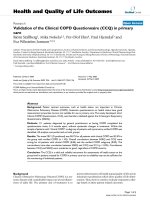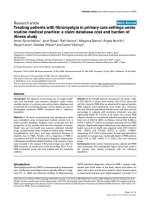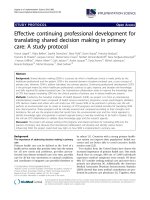Mens Health in Primary Care (Current Clinical Practice) 2016
Bạn đang xem bản rút gọn của tài liệu. Xem và tải ngay bản đầy đủ của tài liệu tại đây (9.29 MB, 312 trang )
Current Clinical Practice
Series Editor: Neil S. Skolnik
Joel J. Heidelbaugh Editor
Men's
Health in
Primary
Care
Current Clinical Practice
Series editor
Neil S. Skolnik
More information about this series at />
Joel J. Heidelbaugh
Editor
Men’s Health
in Primary Care
Editor
Joel J. Heidelbaugh, MD, FAAFP, FACG
Departments of Family Medicine and Urology
University of Michigan Medical School
Ann Arbor, NY, USA
Current Clinical Practice
ISBN 978-3-319-26089-1
ISBN 978-3-319-26091-4
DOI 10.1007/978-3-319-26091-4
(eBook)
Library of Congress Control Number: 2015960810
Springer Cham Heidelberg New York Dordrecht London
© Springer International Publishing Switzerland 2016
This work is subject to copyright. All rights are reserved by the Publisher, whether the whole or part of
the material is concerned, specifically the rights of translation, reprinting, reuse of illustrations, recitation,
broadcasting, reproduction on microfilms or in any other physical way, and transmission or information
storage and retrieval, electronic adaptation, computer software, or by similar or dissimilar methodology
now known or hereafter developed.
The use of general descriptive names, registered names, trademarks, service marks, etc. in this publication
does not imply, even in the absence of a specific statement, that such names are exempt from the relevant
protective laws and regulations and therefore free for general use.
The publisher, the authors and the editors are safe to assume that the advice and information in this book
are believed to be true and accurate at the date of publication. Neither the publisher nor the authors or the
editors give a warranty, express or implied, with respect to the material contained herein or for any errors
or omissions that may have been made.
Printed on acid-free paper
Humana Press is a brand of Springer
Springer International Publishing AG Switzerland is part of Springer Science+Business Media
(www.springer.com)
Acknowledgments
For my patients, my students and residents, my mentors, and my colleagues
For the advancement of men’s health worldwide
With deepest gratitude to my coauthors for their inspiration and contributions
And to my family for their love and support
v
Preface
What is men’s health? “Guy problems. You know, prostate and genital problems.
They die of heart attacks and strokes mostly. Working out at the gym. Oh yeah,
some cancers too. And stupid, risky behaviors. Guys like to take chances, and don’t
always think about what might happen to them. We should know better. Yeah, that
should just about cover it…” [1].
While the above answer is quite superficial in its scope, it should be widely
acknowledged that men on the worldwide arena share the common factor that they
are at a higher risk of premature death from the majority of adverse health conditions that we would expect to affect men and women equally. Ultimately, men’s
health as a subgenre of medicine needs to progress beyond a discussion simply
reflecting morbidity and mortality statistics, urology, and sexual function concerns,
to focus on the circumstances that influence men to either seek or not seek preventive and holistic medical care.
In the past decade, the field of men’s health has begun to evolve and gain some
modest traction, not simply as an answer to “women’s health,” but more formally to
recognize, research, and address medical and social issues predicated upon inherent
disparities affecting the male gender. However, creating a distinct field of “men’s
health” is still an admirable goal, one that should be multidisciplinary and should
focus on the unique biopsychosocial factors that impact the health of men across the
life cycle.
In reviewing the currently available primary care and specialty-oriented men’s
health-affiliated journals and textbooks, I continue to see a growing need for primary care clinicians to have a multidisciplinary and evidence-based reference guide
to the diseases and disorders that affect male patients of all ages, with a comparative
epidemiologic focus. Although the majority of references for this target audience on
general pediatric and adult medical problems are considered to be comprehensive
and up to date, few are specifically targeted at those diseases and disorders that
unequally affect male patients. Hopefully, future provisions of men’s health will be
supported through such legislature as the Affordable Care Act, which should help to
improve many parameters of healthcare outcomes in men.
vii
viii
Preface
The collection of authors assembled for this textbook represents a cohort of
nationally and recognized scholars, clinicians, and researchers, many of whom are
the leading experts on their respective topics. They have provided current evidencebased reviews and practice recommendations on best practice strategies to approach
common clinical concerns and disorders in men’s health.
I would like to sincerely thank all of the authors who donated their extremely
valuable time and energy to believe and participate in this textbook project. A very
special thanks is given to Patrick Carr and his excellent staff at Springer for their
assistance in the production and timely publication of this textbook.
It is my hope that this textbook spawns a broader interest in recognizing and
addressing disparities in men’s health and provides a practical reference for learners
and clinicians who care for common disorders in male patients across the globe.
Best wishes
Reference
1. Random male patient interview conducted by editor, when soliciting advice on what to include
in a textbook on men’s health, Ypsilanti Health Center, Ypsilanti, Michigan, June 11, 2004.
Appears in Heidelbaugh JJ (ed.) Clinical Men’s Health: Evidence in Practice. Philadelphia,
PA: Saunders/Elsevier, 2008
Ypsilanti, MI
Ann Arbor, MI
Joel J. Heidelbaugh
Series Editor Introduction
As a practicing primary care physician, I take care of many men who suffer from
chronic diseases including hypertension, high cholesterol, diabetes, heart disease,
COPD, and BPH. I also have noticed that many men first present to the doctor at the
insistence of their spouses, an observation that is not mine alone. While I knew that
men have a shorter life expectancy than women, I had not given much thought to the
fact that from their first year of life onward, despite many occupational and social
advantages when compared to women, men are more likely to die at any given age
than their female counterparts. I had not thought a lot about the possibility that this
increase in mortality may be partly attributable to behavioral choices and the consequent chronic diseases that men suffer from. Like a boy who grows up in the forest
and never gives much thought that the trees may simultaneously form and obscure
the landscape, I had never thought much about social determinant of men’s health.
I had never given direct attention to the distinct interaction between male expectations, stresses, the behavioral choices that are often a by-product of these stresses
and expectations, as well as their relation to chronic disease and mortality.
It is seldom, after 30 years in the practice of medicine, to be provoked to think
anew about a common problem that influences the health of the patients that I take
care of each and every day. This book provokes such thought and provides data and
the commentary which sheds new light on this common issue. For this, the authors
deserve our thanks and attention.
Neil Skolnik, MD
Professor of Family and Community Medicine
Temple University School of Medicine
Associate Director
Family Medicine Residency Program
Abington Memorial Hospital
ix
Contents
1
Men’s Health in 2010s: What Is the Global Challenge?.....................
Roland J. Thorpe, Jr. Derek M. Griffith, Keon L. Gilbert,
Keith Elder, and Marino A. Bruce
2
Masculinity in Men’s Health: Barrier or Portal
to Healthcare? ........................................................................................
Derek M. Griffith, Keon L. Gilbert, Marino A. Bruce,
and Roland J. Thorpe Jr.
3
4
5
1
19
Health-Seeking Behavior and Meeting the Needs
of the Most Vulnerable Men ..................................................................
Keon L. Gilbert, Keith Elder, and Roland J. Thorpe Jr.
33
Providing Preventive Services to Men:
A Substantial Challenge? ......................................................................
Masahito Jimbo
45
The Evidence-Based Physical Examination
of the Child and Adolescent Male.........................................................
David A. Levine and Makia E. Powers
57
6
Caring for the Adolescent Male ............................................................
Cullen N. Conway, Samuel Cohen-Tanugi, Dennis J. Barbour,
and David L. Bell
89
7
The Evidence-Based Well Male Examination in Adult Men .............
Mark J. Flynn
103
8
Promoting Cardiovascular Health in Men ..........................................
Michael Mendoza and Colleen Loo-Gross
125
9
Male Sexual Health ................................................................................
Harland Holman and Mark Armstrong
145
xi
xii
Contents
10
Sexually Transmitted Infections in Men ..............................................
Charles Kodner
11
Benign Prostatic Hyperplasia and Lower Urinary
Tract Symptoms .....................................................................................
Abdul Waheed
12
Testicular, Scrotal, and Penile Disorders .............................................
Michael A. Malone and Ahad Shiraz
13
Hypogonadism: The Relationship to Cardiometabolic
Syndrome and the Controversy Behind Testosterone
Replacement Therapy............................................................................
Joel J. Heidelbaugh, Anthony Grech, and Martin M. Miner
165
197
225
249
14
Prostate Cancer: A Primary Care Perspective....................................
Robert Langan
269
15
Caring for Men Who Have Sex with Men ...........................................
Jim Medder
283
Index ................................................................................................................
301
Contributors
Mark Armstrong, DO Department of Family Medicine, Spectrum Health, Grand
Rapids, MI, USA
Dennis J. Barbour, Esq Partnership for Male Youth, Washington, DC, USA
David L. Bell, MD, MPH Columbia University Medical Center, New York,
NY, USA
Marino A. Bruce, PhD, MSRC, MDiv, CRC Department of Criminal Justice and
Sociology, Jackson State University, Jackson, MS, USA
Center for Health of Minority Males (C-HMM), Myrlie Evers-Williams Institute for
the Elimination of Health Disparities, University of Mississippi Medical Center,
Jackson, MS, USA
Samuel Cohen-Tanugi Columbia University Medical Center, New York, NY, USA
Cullen N. Conway, MPH Columbia University Medical Center, New York,
NY, USA
Keith Elder, PhD, MPH, MPA Department of Health Management and Policy,
College for Public Health and Social Justice, Saint Louis University, St. Louis,
MO, USA
Mark J. Flynn Family Medicine Residency, Naval Hospital Camp Pendleton,
Camp Pendleton, CA, USA
Keon L. Gilbert, DrPH, MA, MPA Department of Behavioral Sciences and
Health Education, Salus Center, College for Public Health and Social Justice,
St. Louis, MO, USA
Anthony Grech, MD Departments of Family Medicine and Internal Medicine,
University of Michigan Medical School, Ann Arbor, MI, USA
Derek M. Griffith, PhD Institute for Research on Men’s Health, Center for
Medicine, Health and Society, Vanderbilt University, Nashville, TN, USA
xiii
xiv
Contributors
Joel J. Heidelbaugh, MD Departments of Family Medicine and Urology,
University of Michigan Medical School, Ann Arbor, MI, USA
Harland Holman, MD Spectrum Family Medicine, Family Medicine Residency
Clinic, Grand Rapids, MI, USA
Masahito Jimbo, MD, PhD, MPH Department of Family Medicine and Urology,
University of Michigan, Ann Arbor, MI, USA
Charles Kodner, MD Department of Family and Geriatric Medicine, University
of Louisville School of Medicine, Louisville, KY, USA
Robert Langan, MD Department of Family Medicine, St. Luke’s University
Hospital, Bethlehem, PA, USA
David A. Levine, MD Department of Pediatrics, Morehouse School of Medicine,
Atlanta, GA, USA
Colleen Loo-Gross, MD, MPH Department of Family Medicine, University of
Rochester—Highland Hospital, Rochester, NY, USA
Michael A. Malone, MD Department of Family and Community Medicine, Penn
State College of Medicine, Hershey, PA, USA
Jim Medder, MD, MPH Department of Family Medicine, University of Nebraska
Medical Center, Omaha, NE, USA
Michael Mendoza, MD, MPH, MS Department of Family Medicine, University
of Rochester—Highland Hospital, Rochester, NY, USA
Department Public Health Sciences, University of Rochester—Highland Hospital,
Rochester, NY, USA
Martin M. Miner, MD Department of Family Medicine and Urology, Warren
Alpert School of Medicine, Brown University, Providence, RI, USA
Men’s Health Center, The Miriam Hospital, Providence, RI, USA
Makia E. Powers, MD, MPH Department of Pediatrics, Morehouse School of
Medicine, Atlanta, GA, USA
Ahad Shiraz, MD Department of Family and Community Medicine, Penn State
College of Medicine, Hershey, PA, USA
Roland J. Thorpe Jr., PhD Department of Health, Behavior and Society, Program
for Research on Men’s Health, Hopkins Center for Health Disparities Solutions,
Johns Hopkins Bloomberg School for Public Health, Baltimore, MD, USA
Abdul Waheed, MD Department of Family and Community Medicine, Penn State
University College of Medicine, Milton S. Hershey Medical Center, Hershey,
PA, USA
Chapter 1
Men’s Health in 2010s: What Is the Global
Challenge?
Roland J. Thorpe Jr., Derek M. Griffith, Keon L. Gilbert, Keith Elder,
and Marino A. Bruce
In recent decades, there has been a dramatic increase in attention toward men’s health
internationally in the popular press and scientific literature [1–3]. A number of factors
have contributed to this heightened awareness of men’s health. These include the
recognition that there are different body image and health-related issues for men: the
increase in the use of reproductive/sexual health medications (e.g., phosphodiesterase
type 5 inhibitors), weight loss/maintenance programs for men (e.g., Weight Watchers
R.J. Thorpe Jr., PhD (*)
Department of Health, Behavior and Society, Program for Research on Men’s Health,
Hopkins Center for Health Disparities Solutions, Johns Hopkins Bloomberg School of Public
Health, 624 N. Broadway, Suite 708, Baltimore, MD 21205, USA
e-mail:
D.M. Griffith, PhD
Institute for Research on Men’s Health, Center for Medicine, Health and Society,
Vanderbilt University, PMB #351665, 2301 Vanderbilt Place, Nashville, TN 37235-1665, USA
e-mail: derek.griffi
K.L. Gilbert, DrPH, MA, MPA
Department of Behavioral Sciences and Health Education, Salus Center, College for Public
Health and Social Justice, 3545 Lafayette Ave, St. Louis, MO 63104, USA
e-mail:
K. Elder, PhD, MPH, MPA
Department of Health Management and Policy, College for Public Health and Social Justice,
Saint Louis University, 3545 Lafayette Ave., Room 369, St. Louis, MO 63104, USA
e-mail:
M.A. Bruce, PhD, MSRC, MDiv, CRC
Department of Criminal Justice and Sociology, Jackson State University,
18830, 360 Dollye M.E. Robinson Building, Jackson, MS 39217, USA
Center for Health of Minority Males (C-HMM), Myrlie Evers-Williams Institute for the
Elimination of Health Disparities, University of Mississippi Medical Center,
2500 North State Street, Jackson, MS 39212, USA
e-mail:
© Springer International Publishing Switzerland 2016
J.J. Heidelbaugh (ed.), Men’s Health in Primary Care, Current Clinical Practice,
DOI 10.1007/978-3-319-26091-4_1
1
2
R.J. Thorpe Jr. et al.
Online for Men, Nutrisystem® For Men), and the emergence of reports documenting
men’s poor health outcomes in Europe, Asia, and other parts of the world [2–5].
However, there continues to be a substantial paucity of research, practice, and advocacy focused on improving the lives of men worldwide and within the USA.
Around the world, men experience premature mortality compared to women [2, 3,
6]. This is somewhat paradoxical given that men have historically had social and economic advantages that are often associated with being male that do not appear to be
associated with better health outcomes [7, 8]. Although there is mounting evidence that
premature mortality is largely due to men tending to engage in high-risk-taking behaviors [9], premature mortality is likely a result of a more broad and complex set of social,
behavioral, physiological, and psychosocial factors that are commonly unaddressed in
most men’s health research [6, 8, 10–16]. Failure to understand relationships between
these factors will continue to impede the progress of the nascent field of men’s health.
The objectives of this chapter are to (1) define men’s health, (2) describe the
health profile of men, (3) discuss the challenges of providing adequate men’s health,
(4) discuss the impact of the Affordable Care Act (ACA) on preventive healthcare
for men, and (5) provide future directions for improving men’s health worldwide.
What Is Men’s Health?
Men’s health has been categorized into four general areas: (a) conditions that are
unique to men (e.g., prostate cancer and erectile dysfunction), (b) diseases or illnesses
that are more prevalent in men (e.g., cardiovascular disease, stroke), (c) health problems for which risk factors are different in men (e.g., obesity), and (d) health issues for
which different interventions to achieve improvements in health and well-being at the
individual or the population level are required for men (e.g., access to care) [17, 18].
Most men’s health dispositions are considered to be modifiable because the primary
causes are social and behavioral—rather than biological [19]. Moreover, behaviors
that affect health outcomes may account for up to 40 % of mortality irrespective of
gender [20]. Because men are more likely than women to engage in over 30 hazardous
behaviors that have been known to increase their risk of injury, morbidity, and mortality, health behaviors help to explain gender differences in health outcomes [9]. This
notion underscores the importance of adequately defining and studying men’s health.
Are We Improving the Lives of Men?
Life Expectancy
In most countries throughout the world, males are more likely than females to die
sooner at every age across the life course, and the gap has not improved in the last
decades [2, 3, 6]. For example, when comparing the life expectancy at birth of males
in the USA to that of males in 21 other highly developed countries (e.g., Australia,
1 Men’s Health in 2010s: What Is the Global Challenge?
3
Fig. 1.1 US male life expectancy at birth relative to 21 other high-income countries, 1980–2006.
Notes: Red circles depict newborn life expectancy in the USA. Grey circles depict life expectancy
values for Australia, Austria, Belgium, Canada, Denmark, Finland, France, Iceland, Ireland, Italy,
Japan, Luxembourg, the Netherlands, New Zealand, Norway, Portugal, Spain, Sweden,
Switzerland, the UK, and West Germany. Source: National Research Council (2011, Figs. 1–3)
Canada, Japan, Sweden, the UK), the life expectancy of males in the USA has consistently remained in the bottom tertile since the 1980s [21] (Fig. 1.1). Furthermore,
males in the USA have the lowest life expectancy when compared to men in other
highly developed countries [21].
The medical and technological advances in the USA over the last century have
extended the length in which people live by approximately 30 years (Fig. 1.2).
However, the gender difference in life expectancy in the USA has widened across
the majority of the twentieth century and into the first decade of the twenty-first
century. By comparing males in the USA to other males around the world and to
females in the USA, this emphasizes the myriad of factors on several levels that
impact men’s health outcomes and provides additional opportunities to improve
men’s health in the USA.
Across racial and ethnic groups, men on average live shorter lives than women
throughout the twentieth century and into the twenty-first century (Fig. 1.3). In
addition to the differences in life expectancy between men and women, racial disparities in health among men are substantial with black men in the USA exhibiting
the shortest life expectancy of any racial/ethnic group of men and Asian and Latino
men having the longest life expectancy compared to white men [10, 22, 23]. Indeed
there is some evidence to suggest that racial disparities are decreasing [24, 25], yet,
for the majority of health indicators, racial and ethnic disparities in health among
men persist [14, 15, 26]. These data make health disparities among groups of men a
keen focus at local, state, and federal public health agendas [27, 28].
4
R.J. Thorpe Jr. et al.
Fig. 1.2 Life expectancy by sex, 1900–2009. Source: 1990–1940 National Vital Statistics Report,
Vol. 50, No. 6, March 21, 2002, Table 12; 1995–1990 US National Center for Health Statistics,
“Health, United States, 2003,” Table 27; 2000–2009: US National Center for Health Statistics,
“Health, United States, 2011,” Table 22
Fig. 1.3 Life expectancy by race and sex, 1900–2009. Source: 1990–1940 National Vital Statistics
Report, Vol. 50, No. 6, March 21, 2002, Table 12; 1995–1990 US National Center for Health
Statistics, “Health, United States, 2003,” Table 27; 2000–2009: US National Center for Health
Statistics, “Health, United States, 2011,” Table 22
Mortality, Morbidity, and Leading Causes of Death
The US age-adjusted mortality rates for the total population and by gender are presented in Fig. 1.4. Although there has been a continuous decline in the age-adjusted
mortality rates for the past seven decades for women and men, the age-adjusted mortality rates are higher for men when compared to women and when compared to the
US population. Furthermore, regarding the men’s health literature in the USA,
research on men of color (e.g., African Americans, Hispanics, Asians, American
Indian or Alaskan Native, Pacific Islanders) is scant [8, 26]. Yet, men of color account
1 Men’s Health in 2010s: What Is the Global Challenge?
5
Fig. 1.4 Age-adjusted mortality rates by sex, 1940–2009. Source: US National Center for Health
Statistics, “National Vital Statistics Reports,” Vol. 60, No. 3, December 29, 2011, Table 1
1400
White Males
Black Males
1147.3
1200
Asian Males
Hispanic Males
1000
876.3
800
623.6
600
494.9
400
200
0
Age-adjusted Death Rate
Fig. 1.5 Age-adjusted mortality rates by race/ethnicity among males, 2009. Source: US National
Center for Health Statistics, “National Vital Statistics Reports,” Vol. 60, No. 3, December 29,
2011, Tables 1 and 2. 1Data for Hispanics is based on estimates
for a considerable amount of the reported gender difference in mortality [9, 29].
African American men have the highest rates of age-adjusted mortality, and Asian
men have the lowest, with White men and Hispanic/Latino men falling between these
two groups (Fig. 1.5). These data support the need for additional research in the USA
focusing on the health of racial/ethnic men, particularly African American men.
Chronic medical conditions encompass the majority of the leading causes of mortality for males in the USA, with heart disease and cancer being the top two leading
causes of death for men (Table 1.1). Over one-third of adult men have some form of
Respiratory disease
Stroke
Diabetes mellitus
Suicide
Alzheimer’s
Influenza/pneumonia
Nephritis
4
5
6
7
8
9
10
African American
males
Heart disease
Cancer
Unintentional
injury
Stroke
Homicide
Diabetes mellitus
Respiratory disease
Nephritis
HIV disease
Septicemia
Diabetes mellitus
Liver disease and cirrhosis
Suicide
Respiratory disease
Stroke
Influenza/pneumonia
Homicide
American Indian/Alaska
native males
Heart disease
Cancer
Unintentional injury
Unintentional injury
Diabetes mellitus
Respiratory disease
Influenza/pneumonia
Suicide
Nephritis
Alzheimer’s
Asian/Pacific Islander males
Cancer
Heart disease
Stroke
Stroke
Diabetes mellitus
Liver disease and cirrhosis
Homicide
Suicide
Respiratory disease
Influenza/pneumonia
Hispanic males
Heart disease
Cancer
Unintentional injury
Source: National Center for Health Statistics: National Vital Statistics Reports, Deaths: Leading Causes for 2009, Vol. 61, No. 7, October 26, 2012, Tables 1
and 2 “Deaths, percentage of total deaths, and death rates for the 10 leading causes of death in selected age groups, by race, ethnicity, and sex, US 2009”
White males
Heart disease
Cancer
Unintentional injury
Rank
1
2
3
Table 1.1 Leading causes of death in men by race/ethnicity, 2009
6
R.J. Thorpe Jr. et al.
1 Men’s Health in 2010s: What Is the Global Challenge?
7
heart disease [30], and nearly one in two men will develop cancer at some point in
their lifetime [31]. It is important to note that only three of the leading causes of
death for men are not considered to be directly related to chronic diseases: unintentional injuries (including drug overdose), suicide, and influenza/pneumonia. These
statistics are noteworthy because there are significant opportunities to consider
behaviors that might impede the progress or delay the onset of chronic conditions.
Race and ethnicity can be useful proxies for a man’s exposure to health-harming
environments and substances, social disadvantage, and health-promoting resources
[32]. Understanding the poor status of men’s health and premature death includes
considering how racialized and gendered social determinants of health shape men’s
lives and experiences, particularly through economic and environmental factors
[13, 14, 27]. The differences among males by race and ethnicity are highlighted in
Table 1.1. Heart disease is the leading cause of death for all racial and ethnic groups
of males except Asian/Pacific Islanders, for whom cancer is the leading cause of
death; these leading causes of death have remained the same for decades. Hence,
only modest progress has been achieved in advancing men’s health and addressing
disparities in mortality in men’s health in the USA. Improving the quality of lives of
men in the USA could lead to improved life expectancy and a higher ranking when
compared to males from other international countries.
Why Is Creating/Providing Adequate Men’s Health Such
a Challenge?
It has been established that the bulk of factors associated with the leading causes of
death among men can be linked to the social determinants. Gender is one of the
most important social determinants of health and health-related behavior, particularly for men, but the study of men’s health and well-being have not always conceptualized men as gendered beings [33–35]. A gendered analysis of male behavior can
further our understanding of the larger contextual influences upon men’s lives,
social roles, and other factors that influence men’s health [36–38].
Gender is one of the most commonly collected but least understood variables in
research [39]. Despite the volume of research that has examined the role that masculinity plays in men’s health outcomes, we still know relatively little about specific
social–biological pathways through which gendered arrangements become embodied as differences in health among men or between males and females [39]. Gendered
processes—social relations and practices associated with biological sex—are the
complex array of social relations and practices attached to gender that are rooted in
biology and shaped by environment and experience [33, 39]. Thus, most health
outcomes for men are the result of factors associated with both sex and gender, but
researchers often fail to consider both. Furthermore, gender is both a structural characteristic that helps to define systems of social inequality and an individual level
8
R.J. Thorpe Jr. et al.
experience. It is critical to explore how it is understood, experienced, and practiced
daily at both levels [40–42]. The theories that have been used to explain men’s
health rarely examine the unique mechanisms and pathways that explain differences
between men and women or among men [7].
Health scientists and practitioners should also consider the impact of psychosocial stress on men’s lives and men’s health. Stress is a socially patterned and contextual phenomenon affected by cultural, economic, and social factors and structures
[43–44] that shape the social gradient in health [45–47]. Much of the literature on
stress and coping in men builds on an interactional model of stress that highlights
the social and cultural context of stress and coping [48] and argues that perceptions
of stressors are the primary determinants of behavior and health status [49].
Stress directly and indirectly contributes to high rates of unhealthy behaviors,
chronic disease, and premature mortality among men [6]. Psychological research on
men’s health and masculinity often presents stress as an acontextual, psychological
construct with universal mechanisms and pathways [49], yet characteristics (e.g.,
race, ethnicity, life stage) that are socially meaningful in their societal context [50,
51] shape what aspects of life are deemed stressful. Research has highlighted the
importance of examining how social and cultural expectations of men and women
shape their behavioral strategies for coping with stress; these patterns may help
explain not only racial disparities in health outcomes but how these patterns vary by
gender as well [46, 48, 52]. What remains unclear, however, is how men’s conceptions of various aspects of masculinity may shape men’s physiological or behavioral
response to stress [6, 48, 53, 54].
Across disciplines theories of masculinity have historically presumed that there
is one, universally accepted definition of masculinity [29, 55]. However, what masculinity means to men and the salience of different aspects of masculinity that
change over the adult life span [56] may vary by race, ethnicity, socioeconomic
status (SES), and geographic location [57]. Each phase of the life cycle can be distinguished in part by a man’s efforts to fulfill role performance goals [36, 53]: educational and professional preparation in the preadult and early adult years, being a
provider for himself and his family in the middle adult years, and dignified aging as
men move into and through older adulthood [53, 58]. These goals represent social
and cultural pressures that change as men age, and these strains are rooted in efforts
to perform certain masculinities and fulfill social roles and responsibilities [50].
According to Pyke [59], this focus on the primacy of the success of the male
career legitimizes hegemonic notions of masculinity and gender inequality. Men
who are unable to attain the masculine hegemonic ideals of white, heterosexual
middle- and upper-class men may make use of other constructs of masculinity and
personal assets to conceptualize and enact what they deem the most important
aspects of masculinity [59]. This is an important distinction to make because it
highlights how manhood is inherently racialized and class bound [60], which has
direct implications on provisions of healthcare for the man, his family, and his
community.
1 Men’s Health in 2010s: What Is the Global Challenge?
9
Is the ACA Appropriately Poised to Improve the Preventive
Healthcare of Men?
The Patient Protection and Affordable Care Act (ACA) of 2010 is a piece of US
legislation that was written to provide access to healthcare for all American citizens.
A key element of the approach to provide universal healthcare coverage was to
expand Medicaid coverage for low-income wage earners. As a result, the ACA
would have the potential to have a greatly positive impact on men’s health in the
USA because men who did not qualify for state-sponsored health insurance prior to
ACA could now have access to some form of coverage. In many cases, the financial
barriers to healthcare services have been reduced considerably by ACA.
There are also other provisions in ACA that could improve health outcomes
among underserved men and reduce and eliminate existing racial/ethnic disparities.
These include free coverage of preventive care services, investments in the development of health teams and medical homes to manage chronic conditions in minority
communities, and greater emphasis on methods to improve language services and
community outreach in underserved communities. The extension of affordable
insurance coverage through the new health insurance marketplace in 2014 was
designed to ensure that individuals have a choice for quality, affordable health insurance. Subsidies were also to be provided so that all Americans who desired health
insurance could afford it. Lastly, the ACA increased funding for community health
centers, which provide comprehensive medical care for everyone regardless of their
ability to pay. These provisions would allow health centers to double the number of
patients that they see over the next several years. This is particularly salient for
underserved communities as the majority of the 20 million patients receiving healthcare at community health centers are low income, uninsured, or are members of
racial/ethnic minority groups [61].
While these policy-level solutions target all Americans, low-income minority
men have perhaps the greatest potential to benefit given the social and economic
constraints that impair their ability to seek timely and appropriate medical care. It is
also important to note that the benefits of ACA are not limited to men of color born
in the USA. Males make up the majority of undocumented immigrants, with a large
segment of this group being classified as Hispanic or Latino. Undocumented immigrants are not penalized or required to purchase health insurance; however, immigrant men may qualify for state and local health programs such as community health
and migrant clinics under the ACA [62]. This access to healthcare could have implications for millions of minority immigrant men whose primary access to healthcare
prior to ACA was the emergency room [63].
The ACA is a pathway that can enhance the health of men overall; however, the
future remains unclear about the manner and degree to which this law improves
men’s health. A caveat is that each state in the USA can select its level of ACA coverage. As such the states with the greatest need for Medicaid expansion have only
adopted portions of the ACA. States with the highest level of unemployment, poverty, and poor health outcomes for men (e.g., Alabama, South Carolina, Louisiana,
10
R.J. Thorpe Jr. et al.
Mississippi, and Texas) have refused to expand Medicaid in the manner outlined in
the ACA. Millions of minority native and immigrant men will continue to have
restricted access to healthcare because of the financial and legal barriers to health
insurance that provide opportunities for preventative rather than acute care [64].
Men’s health will move forward as the national healthcare narrative changes, yet
there must be a national commitment to men’s health over the life span. This must
involve a greater commitment of resources via the federal government to fund
research and provide specified training of researchers and clinicians who will focus
on men’s health. As important, the narrative must change concerning where healthcare is generated for men. The doctor’s office is absolutely integral to healthcare
delivery, yet public health, healthcare organizations, and schools must improve the
awareness, particularly for young boys and men, that health and health maintenance
is produced outside of the doctor’s office [65]. Aggressive investment in all facets
of men’s health research, practice, and promotion will position the USA to make
significant advancements in the health of males from infancy to advanced age across
the globe.
Future Directions for Improving Men’s Health
Advancing our knowledge of men’s health and health disparities is critical to
improving the lives of men worldwide. This involves a sustainable public health and
medical infrastructure that is conducive and appropriate for men. Below are some
recommendations that should be considered by researchers, policymakers, and
practitioners. First, understanding men’s health and men’s health disparities requires
an interdisciplinary approach. Currently much of the work is viewed through individual disciplinary perspectives, which limit our ability to critically think about men
and their lives with a wider and perhaps more comprehensive conceptual framework [29]. The contexts in which men live are comprised of social, economic, and
political structures that intersect to shape life chances in ways that influence behaviors that can have implications for men’s health indicators and outcomes. Such an
initiative requires health scientists and practitioners to consider the health of men as
a function of both individual and environmental factors. A focus on comprehensive
men’s health must be more than a pursuit to understand biological mechanisms
associated with gender-specific diseases such as prostate cancer and erectile dysfunction. There is considerable room to explore the environments and ways in
which men live that elevate their risks for disability, disease, and premature death.
Such exploration extends beyond disciplinary boundaries and calls for investigator
teams comprised of individuals from the health sciences, social sciences, and the
humanities. Interdisciplinary teams are well poised to address some of the complex
issues associated with men’s health, thereby increasing the likelihood that health
indicators and outcomes would markedly improve.
Second, the effort to understand and improve men’s health requires a consideration of the existing theoretical frameworks. Sound theories afford scholars the









